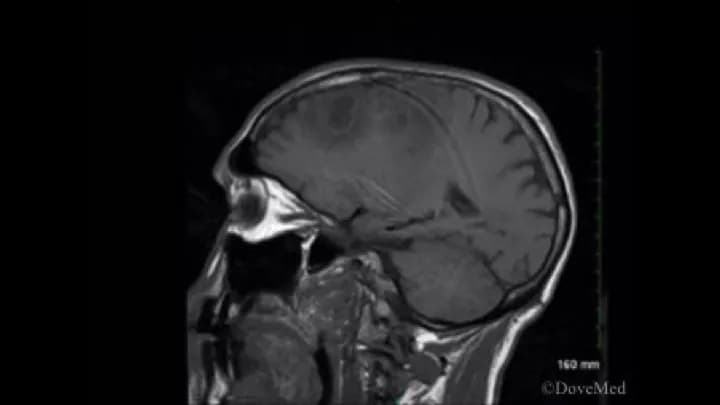What are the other Names for this Condition? (Also known as/Synonyms)
- GBM (Glioblastoma Multiforme)
- Glioblastoma
- Grade IV Astrocytoma
What is Glioblastoma Multiforme? (Definition/Background Information)
- Glioblastoma Multiforme (GBM, or simply Glioblastoma) is the most severe form of astrocytoma, a type of cancer of the brain. It is characterized by the formation of tumors in the brain, developing from astrocytes. Astrocytes are glial cells that support nerve cells
- GBM tumors grow quickly and spread to neighboring brain tissue. It is one of the deadliest forms of brain cancer
- These tumors are most commonly found in the cerebral hemispheres of the brain, especially the frontal and temporal lobes. However, tumors have also been observed in the brainstem and spinal cord
- Glioblastoma Multiforme is generally observed in older patients, and hence, being over the age of 50, is considered a risk factor for GBM
- The exact cause of the condition is under investigation. However, genetic mutations have been reported to be potential causes of Glioblastoma Multiforme
- Headaches, nausea, sensory loss, vision loss, cognitive impairment, seizures, etc., are some known symptoms associated with this type of brain cancer. A healthcare provider might use imaging studies and tumor biopsy to arrive at a diagnosis of GBM
- Treatment options for Glioblastoma Multiforme include surgery, chemotherapy, and radiation therapy. Most individuals with GBM have a median life expectancy of 15 months after diagnosis
Who gets Glioblastoma Multiforme? (Age and Sex Distribution)
- While Glioblastoma Multiforme can occur in individuals of all ages, it is reported to be more common in older adults
- Both males and females can develop GBM
- All racial and ethnic groups are at risk; the condition is seen worldwide
What are the Risk Factors for Glioblastoma Multiforme? (Predisposing Factors)
The risk factors for Glioblastoma Multiforme include:
- Individuals over the age of 50 years are at a higher risk of developing GBM tumors
- Some studies have shown that extensive cell (mobile) phone usage may increase the risk of developing brain tumors. While this has not been proven, some studies support this hypothesis
It is important to note that having a risk factor does not mean that one will get the condition. A risk factor increases ones chances of getting a condition compared to an individual without the risk factors. Some risk factors are more important than others.
Also, not having a risk factor does not mean that an individual will not get the condition. It is always important to discuss the effect of risk factors with your healthcare provider.
What are the Causes of Glioblastoma Multiforme? (Etiology)
The cause of Glioblastoma Multiforme is currently unknown.
- Research studies indicate that genetic mutations may cause the formation of these brain tumors
- Studies on head injuries, N-nitroso compounds, occupational hazards, and exposure to electromagnetic field as potential causes of GBM have all been inconclusive
What are the Signs and Symptoms of Glioblastoma Multiforme?
The common signs and symptoms of Glioblastoma Multiforme (GBM) include:
- Headaches
- Nausea and vomiting
- Loss of appetite
- Personality changes
- Slowed cognitive function
- Sensory and vision loss
- Seizures
How is Glioblastoma Multiforme Diagnosed?
To diagnose Glioblastoma Multiforme, imaging studies and tumor biopsies may be conducted.
- CT and MRI scans are the most common form of brain imaging. In these scans, Glioblastomas usually appear as irregularly-shaped lesions
- Necrosis in the biopsies could be indicative of Glioblastoma
Many clinical conditions may have similar signs and symptoms. Your healthcare provider may perform additional tests to rule out other clinical conditions to arrive at a definitive diagnosis.
What are the possible Complications of Glioblastoma Multiforme?
Complications from Glioblastoma Multiforme usually arise due to treatment that the individual is undergoing. These may include:
- Side effects from chemotherapy
- Possible brain damage during surgery to remove the tumor. Motor skills and speech may be impaired or lost as a result of the invasive procedure
How is Glioblastoma Multiforme Treated?
To treat Glioblastoma Multiforme, a variety of options are available, including:
- Surgery, to remove the tumor
- Radiation, to kill the tumor cells
- Radiosurgery, a specialized radiation method
- Chemotherapy, involving special drugs to kill the tumor cells
Often times, treatment is not effective in removing the tumors unless they are combined. Since surgery is limited because of the presence of healthy brain tissue around the tumor, it is often followed by radiation and chemotherapy to give the patient the best possible outcome.
How can Glioblastoma Multiforme be Prevented?
- Currently, no prevention methods have been reported against Glioblastoma Multiforme
- To prevent cancer recurrences, radiation therapy and chemotherapy are recommended following surgery
What is the Prognosis of Glioblastoma Multiforme? (Outcomes/Resolutions)
- Prompt diagnosis and treatment of Glioblastoma Multiforme is important in order to give the patient higher survival chances
- Individuals with GBM have an average or mean life expectancy of 15 months after diagnosis of the tumor
- However, there are reports of individuals surviving beyond 15 months with the use of combined treatment methods of surgery, radiation, and chemotherapy
Additional and Relevant Useful Information for Glioblastoma Multiforme:
The following DoveMed website link is a useful resource for additional information:
https://www.dovemed.com/health-topics/neurological-institute/
Related Articles
Test Your Knowledge
Asked by users
Related Centers
Related Specialties
Related Physicians
Related Procedures
Related Resources
Join DoveHubs
and connect with fellow professionals


0 Comments
Please log in to post a comment.